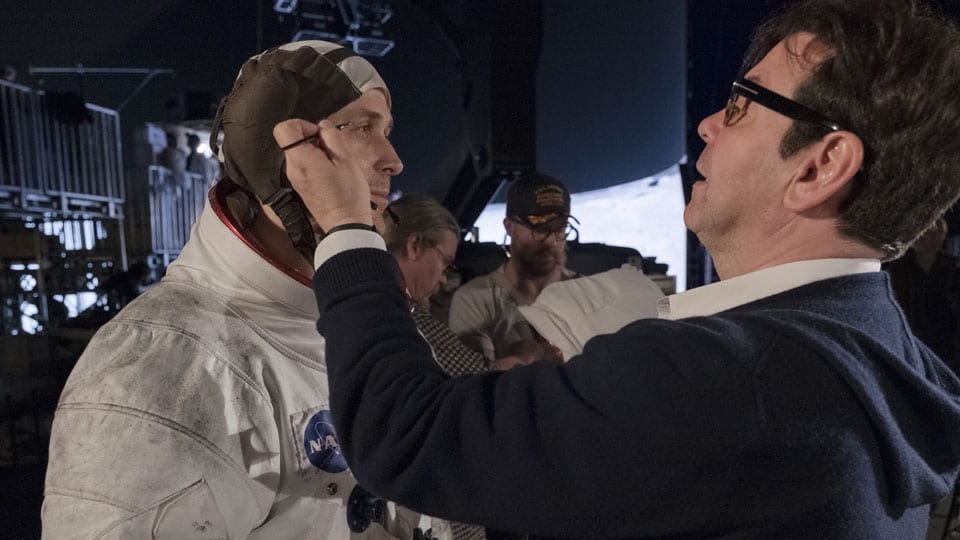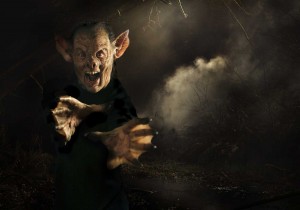
After the pilot was shot, Burman was recruited to the show as he had a lengthy career already behind him creating monsters, aliens and specialty characters. “They had done the pilot and Andrew Clement did some beautiful work in it,” Burman recollected. “For whatever reason, they decided to go somewhere else [for the show’s ensuing makeup effects] and contacted me through a referral to [series makeup department head] Jojo Proud. I put in a bid for the first episode. All I knew was there were three bear creatures, but my bid was too high. They went to another vendor, but it didn’t work out. They decided to keep looking and contacted me again at Jojo’s request. She asked them to hire me.”
Grimm’s production started late July of 2011 and ran through April of 2012. Burman had a mere four weeks of down time between the last episode of season one and the first episode of season two. On the break, Burman did makeups for two NBC Grimm promos.
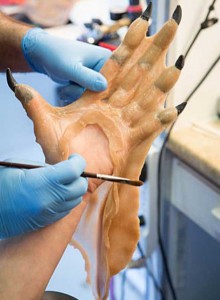 Though B2FX created a full silicon rat-eaten body in five days, they average six days from inception to completion on a special makeup effect with as much as ten days sometimes afforded them. First, Burman will read through the script and break down what effects are needed for that episode. “I’ll sit in on a concept meeting in person if I’m in Portland or over the phone if I’m here,” he explained. “Department heads will go over the whole script and determine what the director envisions. I do a breakdown, a budget, and we dive in. We start scheduling lifecasts and go full throttle until the episode is done. Then, suddenly, there is already a concept meeting and budget to work out for the next episode.“
Though B2FX created a full silicon rat-eaten body in five days, they average six days from inception to completion on a special makeup effect with as much as ten days sometimes afforded them. First, Burman will read through the script and break down what effects are needed for that episode. “I’ll sit in on a concept meeting in person if I’m in Portland or over the phone if I’m here,” he explained. “Department heads will go over the whole script and determine what the director envisions. I do a breakdown, a budget, and we dive in. We start scheduling lifecasts and go full throttle until the episode is done. Then, suddenly, there is already a concept meeting and budget to work out for the next episode.“
After talking to the producers, Burman understood what was required for the run of the show and re-worked the budgetary requirements. From there, it was a complete effort in creating the various unique characters featured on the show, shot in Portland, Oregon. “They really liked what I was doing,” he noted of his first foray into the series. “I did 20 episodes the first season; Jojo handles the straight makeup and takes care of tattoos and the bumps and bruises, and we come in and do the monsters and dead people. I go to set pretty much every episode at least once for a day or two to establish the creature or character makeups that we are doing. Stevie Bettles is my lead artist. He is LA-based, but goes up and stays up in Oregon longer.”
In addition to Burman and Bettles, B2FX has three key additional artists to attend to the many monsters and effects required by Grimm’s scripts, including Randy Westgate, Greg Solomon, and Portland-based Christina Kortum. “She is a local hire and is awesome as far as helping us in whatever capacity is needed,” Burman stated. “She is perfect for doing dead bodies and helps keep us clean and organized.”
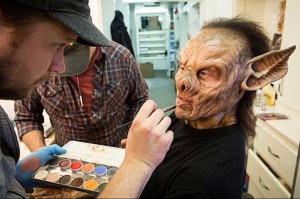 Many of the concepts for the various monsters and creatures come to Burman via sketch artists Constantine Sekeris and Jerad Marantz. “There are no two better people out there for digital design work,” Burman detailed. “Production talks to them about what the creatures are that are coming up. They will do preliminary concept work in Photoshop. Then I get those designs – an image – and I say, “How can I marry the two together in the best possible way?” From there, Burman’s team lifecast actors and begin to sculpt the monster concepts in 3D for eventual realization on set using traditional prosthetic techniques.
Many of the concepts for the various monsters and creatures come to Burman via sketch artists Constantine Sekeris and Jerad Marantz. “There are no two better people out there for digital design work,” Burman detailed. “Production talks to them about what the creatures are that are coming up. They will do preliminary concept work in Photoshop. Then I get those designs – an image – and I say, “How can I marry the two together in the best possible way?” From there, Burman’s team lifecast actors and begin to sculpt the monster concepts in 3D for eventual realization on set using traditional prosthetic techniques.
Though the concept art often comes to him from Sekeris and Marantz, production gives Burman leeway in terms of what works as a makeup. “When it’s a creature, it becomes a very collaborative design in the end,” he said. “They give me free reign to do something that works. If it’s a character like the Dark Riders or Mouse Man, they let me just do it. We will have a dialogue about what they like to see, but there isn’t much time. I’ll work something out in clay and send them a photo in Portland to see that it’s moving in the right direction.”
In one case, for the conceptualization of a bat creature, the artists did a digital rendering that was very distinctly male. “They [the producers] didn’t want it to be obviously male or female, so I made it into something more androgynous,” Burman remarked. “But I try to stay true to the original concept so that it matches their original vision.”
Due to the erratic nature of how special makeup effects are integrated in movies and TV, reliable artists go from show to show and film to film, meaning that schedules are in a constant state of flux. “We have had as many as seven people at one time,” Burman said of workers in his shop who create the sculptures, body elements and makeup appliances used on Grimm, “but we have gone through a large amount of people as everyone is not available at all times. It’s hard to hang onto people when you don’t have work for them every day. You’ll only need people for three-four-five days at a time. This season, I am looking to bring on somebody who is an extension of myself to handle the artistic elements that I normally handle myself. Last season, I was stretched. We had to do 48 different makeups, characters or dead people, and that isn’t everything, so easily more than 50 substantial makeups or dummies.”
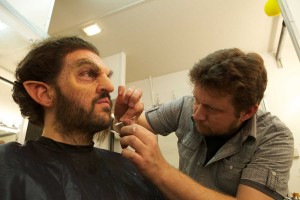 Since Burman is occupied with production, he cannot handle every element of the special makeup effects process, from sculpting to moldmaking to running materials such as foam rubber and silicone — even though he has honed those skills through several decades of work — so his support staff is crucial to the overall success of any project. “Nick Risinger is my coordinator here, and Cherie Smith is in the office,” he said. “She takes care of my schedule and makes sure that all the bills are paid. They are invaluable to me.”
Since Burman is occupied with production, he cannot handle every element of the special makeup effects process, from sculpting to moldmaking to running materials such as foam rubber and silicone — even though he has honed those skills through several decades of work — so his support staff is crucial to the overall success of any project. “Nick Risinger is my coordinator here, and Cherie Smith is in the office,” he said. “She takes care of my schedule and makes sure that all the bills are paid. They are invaluable to me.”
One of Grimm’s most popular characters to come out of the B2FX shop was the aforementioned bat creature. “People respond to him well,” said Burman. “He had great translucency in the ears. Most of the stuff we do is in silicone but not exclusively. We also had a pig character named Orson played by Danny Roebuck, who is awesome. We did an ogre which I really loved played by Eric Edelstein. I like the translucency that it has – when you intrinsically color it, it already looks more like skin than foam can. Then, it is just a matter of tinting it and changing the color here and there, rather than starting from scratch.”
Some of the characters that Burman’s studio have created, like in any film or TV show, did not end up making it into the final show. “There are a few that I was crestfallen that didn’t show up very well,” Burman noted. “We did the dark riders – these terrific makeups – [they featured a] forehead with punched in eyebrows and wigs. We wanted to make them dog-like. They didn’t use them in much of the light in the episode.”
Another character played by Ebbie Roe Smith was a Burman favorite. “We wanted to make him mouse-like,” the Academy Award-winner (Star Trek – 2009 feature film) said. “I wanted to add a touch of mouse in his character without making him a full mouse man. Those are the most fun makeups – when we can take something and tweak it so that it’s not glaring or obvious, but helps tell the story.”
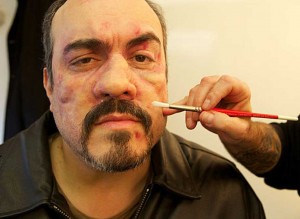 Sometimes, B2FX, given the harried TV schedule, has as little as four days to complete an entire makeup. For example Ebbie Roe Smith was wearing a nose/upper lip/nasal labial fold prosthetic piece, a neck piece, ear tips, teeth and was covered in age stipple and additional coloring. For a Bigfoot character played by Doug Tate, B2FX had to fabricate a face piece, chin piece, punched-hair eyebrows, hand pieces, a lace wig, beard and teeth. “We had to have it on a plane the morning it shot four days later,” Burman said. “Two days on the heels of that, Roger Bart was another Bigfoot that we had to make, plus his stunt double. We also had to a half-bigfoot for Kenneth Mitchell.”
Sometimes, B2FX, given the harried TV schedule, has as little as four days to complete an entire makeup. For example Ebbie Roe Smith was wearing a nose/upper lip/nasal labial fold prosthetic piece, a neck piece, ear tips, teeth and was covered in age stipple and additional coloring. For a Bigfoot character played by Doug Tate, B2FX had to fabricate a face piece, chin piece, punched-hair eyebrows, hand pieces, a lace wig, beard and teeth. “We had to have it on a plane the morning it shot four days later,” Burman said. “Two days on the heels of that, Roger Bart was another Bigfoot that we had to make, plus his stunt double. We also had to a half-bigfoot for Kenneth Mitchell.”
One strange task was to create a bite mark and scratches on a horse. “Randy Westgate applied those pet-safe appliances using gaffe quat,” Burman recalled, noting that he tries to get involved with the creation of the appliances, makeups and dummies to the extent of his time availability. “I sculpt as much as I can, but sometimes, I’ll have somebody else come in. I’ll block it out and they will finish it, or I’ll have someone block it, and I’ll make changes. I like to work in a team-like system. Often times, that means I have to let go of it and let somebody else do it. Sometimes, I’ll take it over to fit what is in my head that I’m not communicating.”
Burman additionally noted that though his schedule is tight on Grimm, he likes to work freshly with each new character. “I have this tendency to do everything as an original piece, not pulling old molds off of the shelf,” he explained. “I watched this behind-the-scenes documentary for Raging Bull where the sound designer destroys his tapes after every film. I love that idea of envisioning something completely new each time, rather than rehashing something already done. This kind of thing deserves that. Each new story should be told anew rather than using elements of the past stories to muddle them together.”
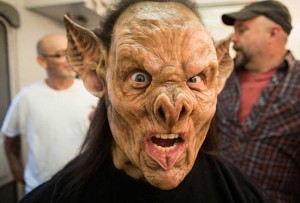 Since his Star Trek makeup Oscar, Burman conceded that he is being offered much higher profile projects more consistently. “I always felt like I was on this path anyway, so it’s hard to know what would be different if anything,” he said. “I always try to do my best work and make everything as good as I can make it. The Oscar was a really wonderful acknowledgement – though it was for one show, it was acknowledging many years of trying to make things as good as I can. The nomination meant more to me than I expected because it was my peers – other makeup artists – saying, “good job.’”
Since his Star Trek makeup Oscar, Burman conceded that he is being offered much higher profile projects more consistently. “I always felt like I was on this path anyway, so it’s hard to know what would be different if anything,” he said. “I always try to do my best work and make everything as good as I can make it. The Oscar was a really wonderful acknowledgement – though it was for one show, it was acknowledging many years of trying to make things as good as I can. The nomination meant more to me than I expected because it was my peers – other makeup artists – saying, “good job.’”
Reflecting on Grimm and his impending second season, Burman was optimistic. “I love the TV work,” he related. “The schedule is more consistently breakneck speed, but it depends on the feature. Grimm’s scheduling was not as bad as Star Trek. I slept less during Star Trek. I think Grimm is a really good show and people are responding really well to it.”




